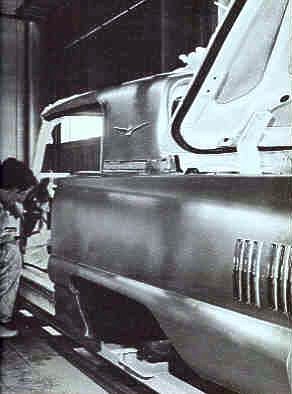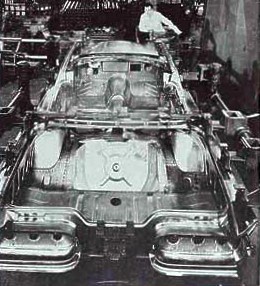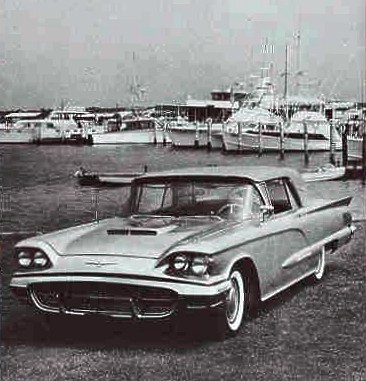1960 Ford Thunderbird
Stainless Steel Hardtops
Two were built for Allegheny Ludlum Steel Corporation
 1960 STAINLESS STEEL THUNDERBIRD DETAILS
1960 STAINLESS STEEL THUNDERBIRD DETAILS
TOTAL BUILT: 2
VIN: 0Y71Y166729
DATE: 20F (June 20, 1960)
VIN: 0Y71Y170331
DATE: 11G (July 11, 1960)
COST: $25,000 each (another $5,000 was later added to the total of each car
for buffing out the stainless panels to achieve the appropriate sheen and
brushed texture)
OPTIONAL EQUIPMENT:
Master-Guide Power Steering ($75.30)
Power Lift Windows ($102.10)
MagicAire Heater-Defroster ($82.90)
Cruise-O-Matic Transmission ($242.00)
Dual-Transistorized Push Button Radio with Antenna ($112.80)
Aquamatic Windshield Washer-Wiper ($13.70)
Outside Hooded Rear View Mirror ($8.10)
Sun Ray Full Wheel Covers ($16.60)
Whitewall Tires Rayon 8.00x14 ($35.70)
Back-Up Lights ($9.50)
Exterior Chrome Dress-Up Package (Non-stock polished stainless steel)
Genuine Leather Interior ($106.20)
Note: Neither car was equipped with rear fender shields, reportedly due to damage to one of the dies on the first stamping attempt. Since repairing the die would be time consuming and expensive, it was decided that the rear fender shields would be omitted. Automotive Mileposts has not inconclusively verified this accounting, and it should be considered speculation until additional information becomes available, if it ever does.
ASSEMBLY NOTES
- Exterior body and roof panels were stamped using T306 alloy, and were processed to give them a satin sheen and a brushed appearance to the final finish.
- Front and rear bumpers, grille, headlight doors, hood scoop, and the rear fender extensions were all constructed using T430, and were highly polished, with a finish comparable to chrome-plated steel.
- Exhaust pipes used T304 stainless, and the mufflers used T409 stainless, reportedly the first use ever of such a material for muffler construction.
- Carbon steel was used for the inner hood, deck lid, hinges, and door panels, and these components were painted white (see inside of deck lid in photo above).
- Inner wheel housings and some floor panel parts were stamped from galvanized steel, as they would have been very difficult to form using stainless steel (see rear wheel housings in photo below).
- The stainless steel Thunderbird bodies were not assembled by Ford, this duty was contracted to a company named Creative Industries in Detroit, Michigan. Welding stainless requires specific skills, and the special needs of these cars would have slowed down the assembly line too much. Creative finished the bodies, which were then sent to Wixom for installation of production parts such as the chassis, trim, and interiors.
THE STORY
 Allegheny Ludlum is one of the largest suppliers of stainless steel and
other alloys in the United States. In 1960, they special ordered two 1960
Thunderbird Hardtops to be built using stainless steel body panels. They
had done this before, back in 1936, when Ford built six Tudor Sedans for
them in stainless steel, all of which went on a coast-to-coast promotional
tour to demonstrate the durability, flexibility, and beauty of stainless
steel. Due to the hard properties of the stainless material, forming body
panels would be more difficult than with conventional carbon steel, so
panels for the two specially-ordered Thunderbirds would need to be stamped
at the end of the production run, after all the carbon steel panels required
for assembly had been done, as well as extras that would be required for
service replacements in the field to repair cars damaged in collisions.
Allegheny Ludlum is one of the largest suppliers of stainless steel and
other alloys in the United States. In 1960, they special ordered two 1960
Thunderbird Hardtops to be built using stainless steel body panels. They
had done this before, back in 1936, when Ford built six Tudor Sedans for
them in stainless steel, all of which went on a coast-to-coast promotional
tour to demonstrate the durability, flexibility, and beauty of stainless
steel. Due to the hard properties of the stainless material, forming body
panels would be more difficult than with conventional carbon steel, so
panels for the two specially-ordered Thunderbirds would need to be stamped
at the end of the production run, after all the carbon steel panels required
for assembly had been done, as well as extras that would be required for
service replacements in the field to repair cars damaged in collisions.
As expected, the dies that had been used for three years to stamp out thousands of panels were rendered useless after the stainless panels were made, and were said to have been scrapped afterward, although we have it from a respected authority that the dies weren't actually destroyed, but would have required time to make them usable again. One panel in particular presented a problem for the stampers. The roof panel was normally stamped using a single die, but the stainless stock material wasn't wide enough to accommodate the width of the roof, so the stainless roof panels were constructed by making two separate roof stampings for each car, then welding the panels together down the center line of the roof to complete the panel.
There were other concerns that needed to be addressed, as well. One was the fact that dielectric corrosion occurs when two dissimilar metals are placed in contact with each other, and since the stainless and conventional steel panels needed to be joined together in many areas, copper spacers were used to prevent them from touching. Standard production nuts, bolts, screws, and other assorted fasteners were already made of stainless steel, so no special parts were required for these components.
When the cars were completed, some of the people involved with the project felt that the stainless steel finish was too shiny, so both cars underwent a buffing process that gave the finish a satiny sheen and brushed look.
 Both cars still survive today, and the stainless steel bodies are as fresh
as they were in 1960. Over the years, some restoration and maintenance
has been performed on both cars, including a freshening up of the engines,
interior carpeting, and other things that would be expected on any well
cared for older vehicle. Padded instrument panels were replaced, as virtually
all of the original pads deteriorated internally and caused the panel to
lose its shape and shrink.
Both cars still survive today, and the stainless steel bodies are as fresh
as they were in 1960. Over the years, some restoration and maintenance
has been performed on both cars, including a freshening up of the engines,
interior carpeting, and other things that would be expected on any well
cared for older vehicle. Padded instrument panels were replaced, as virtually
all of the original pads deteriorated internally and caused the panel to
lose its shape and shrink.
The 1960 Thunderbirds would not be the last cars created with stainless steel. In the mid-sixties, three Lincoln Continental Convertibles were built and used for promotions around the country. All were equipped with dark blue leather interiors, and were titled as 1967 models, which was the last year for the glorious four door Lincoln Continental Convertible. Two of the cars reportedly carried 1966 trim, while the third was decked out in full 1967 regalia.
Since that time, one production automobile has been produced with stainless steel, although it differs greatly from the earlier cars mentioned in this article. The 1981-1983 DeLorean DMC-12 was built in Dunmurry, Northern Ireland for the American market. Named after former Pontiac Division head John DeLorean, who founded the De Lorean Motor Company (space in name intentional), the two seater sports car featured gull-wing doors and a fiberglass underbody to which brushed T304 stainless steel panels were attached. The stainless steel on these cars was not structural, which clearly put them in another class, but it did emphasize the beauty and longevity of the material. The DeLorean Motor Company didn't survive for long, but many of its cars are still around today, and have a devoted following.